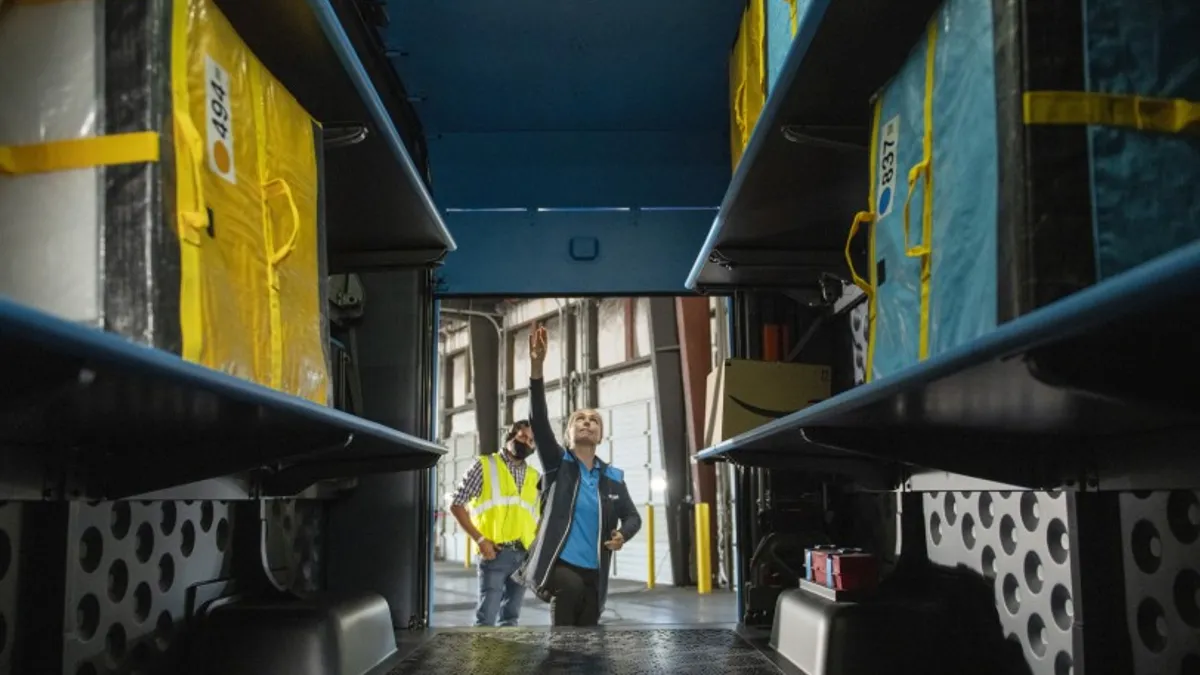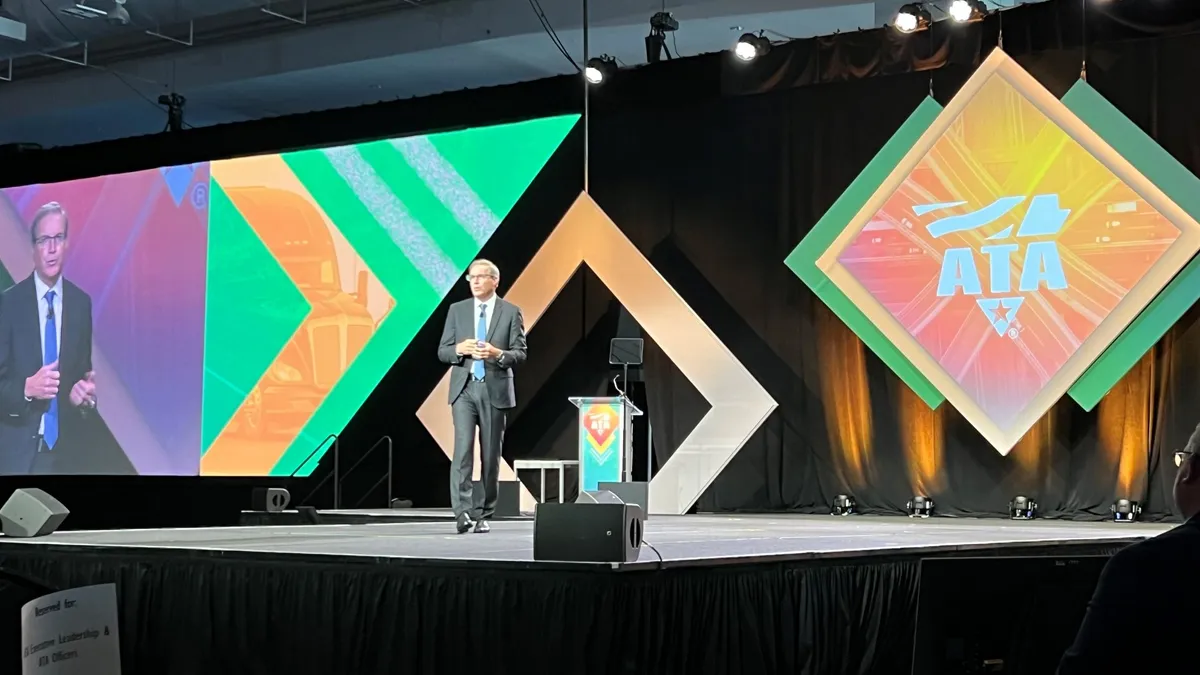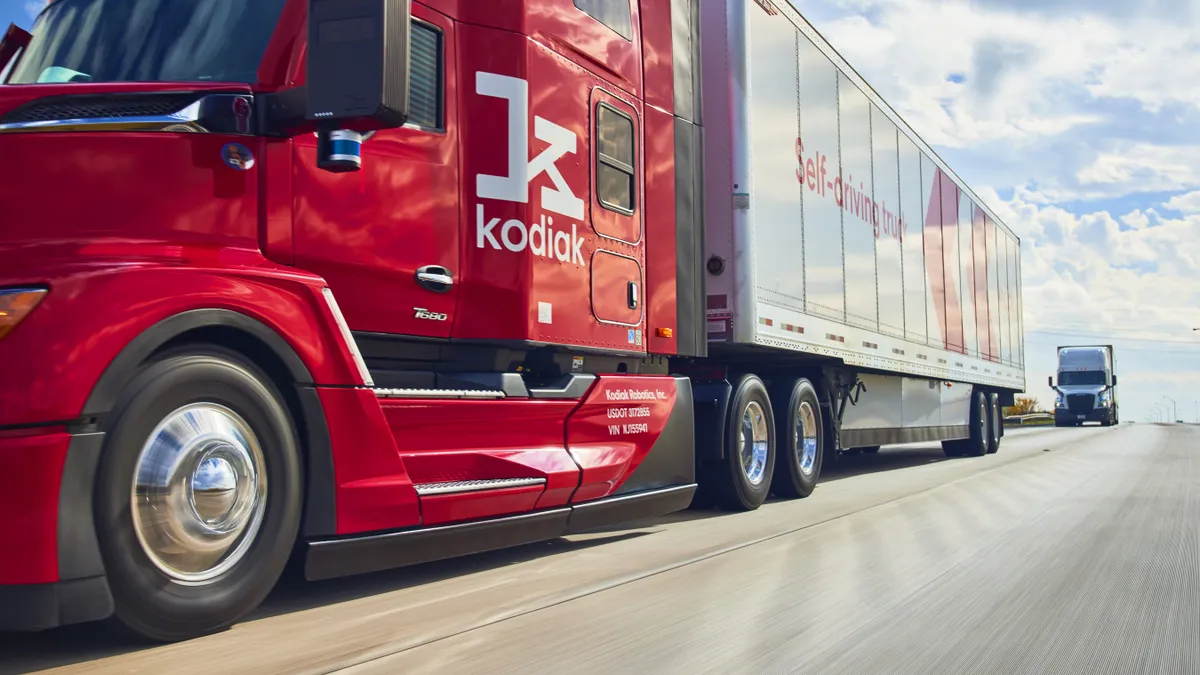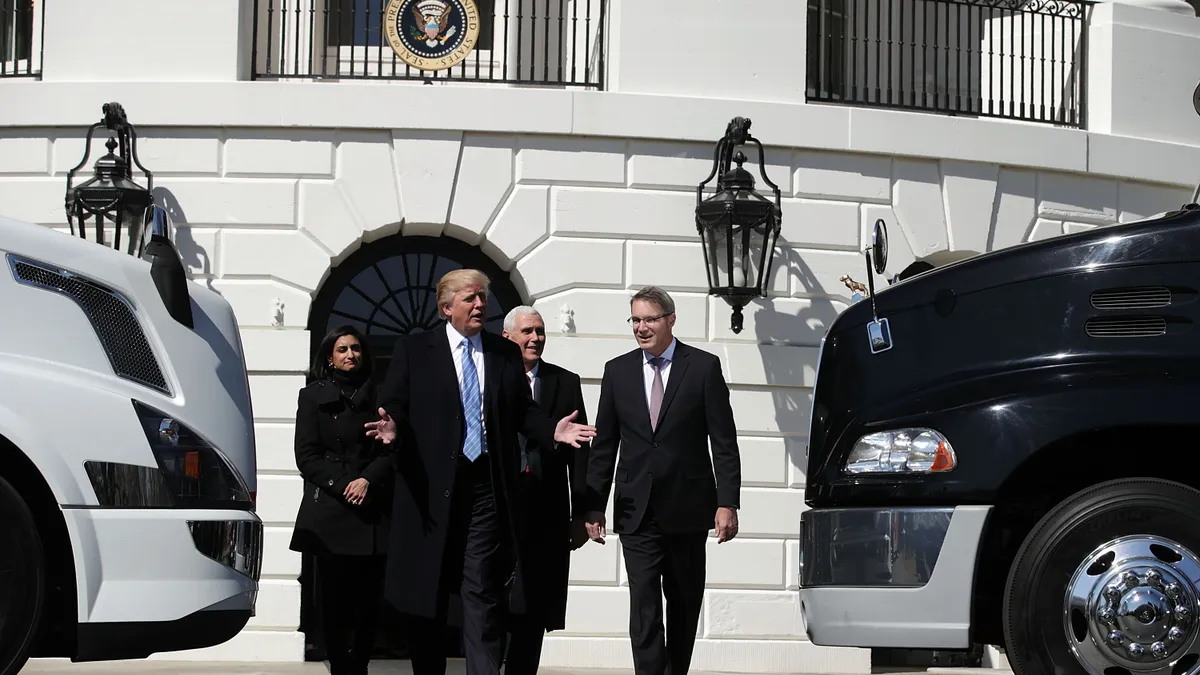This is an opinion piece by Daniel Haake, senior freight planner at HDR. Views do not necessarily reflect those of Transport Dive.
Truck fleets are on the brink of a major transformation: Many will be transitioning to electric trucks as technology develops over the next decade.
There are several factors — besides return on investment — fleet owners need to take into consideration. ROI will be different for each company based on their individual operations, geography and utility regulatory framework in their state.
Given the changing regulatory environment, viability of low/medium duty electric trucks and livability impacts of freight movement, it is critical that fleets begin planning for the future now. Here are eight factors fleet owners should consider when contemplating a fleet transition:
Electric truck models
When people envision electric trucks, most think of large semi-trucks with 53-foot trailers. While there are heavy-duty electric trucks on the market, several technical, market and policy-related challenges limit the practicality of current technology.
With current technology, heavy-duty electric trucks would need to stop to recharge every four hours. It takes diesel trucks 15 to 20 minutes to refuel, while heavy-duty electric trucks (usually with a 500-kilowatt-hour battery) can take more than an hour to charge.
No truck battery, fuel cell or charging technology exists today that can compete with the temporal or range efficiencies of heavy-duty diesel trucks. Additionally, truck drivers and companies will expect a level of certainty on when and where they can recharge.
Task forces like the Charging Interface Initiative, are working to develop a new commercial vehicle charger compliant with the Combined Charging System standard that can deliver 1- to 3-megawatt charge to fill heavy-duty truck batteries in nine to 20 minutes. While technology is advancing quickly, the realities of the trucking industry’s business model and regulatory framework limit how quickly a transition could take place.
While technology is advancing quickly, the realities of the trucking industry’s business model and regulatory framework limit how quickly a transition could take place.

Additionally, the physical installation of these chargers on major trucking routes will still take a significant amount of coordination between states, utilities, truck stops and may require cost sharing between the public and private sectors.
While there are viability challenges today, OEMs such as Volvo and Daimler are expected to unveil trucks that overcome many of these issues in late 2021. However, challenges will remain. What testing requirements will large trucking fleets require before adopting this technology? How long will that take? If successful, how quickly could these trucks be manufactured and made available on the market?
Unlike heavy-duty trucks, light/medium duty trucks’ operational characteristics align with current electric vehicle technology. Light/medium duty electric trucks can typically complete their routes without a recharge. When the trucks “return to base” each day, they can slowly charge overnight.
For example, 10 medium-duty trucks could be charged overnight using Level 2 chargers and only use 70kW of electricity. By doing so, companies can potentially pay lower rates and avoid other demand-related charges, depending on their relationship with the utility and state regulatory framework.
Companies are already making the shift to electric trucks across the globe. In 2019, Amazon ordered 100,000 electric delivery vans from automaker Rivian. UPS, Walmart and PepsiCo have made similar commitments.
Incentives for urban freight deliveries
As e-commerce continues to capture an increasing share of the retail market, fundamental changes in the distribution network are taking place. Large trucks that shipped goods to commercial centers are being replaced by smaller vehicles delivering to consumers’ doorsteps.
The resulting increase in trucks and shift from major retail centers to downtown and neighborhood streets have created significant community impacts. Most notably, the shift has created more congestion, emissions and noise in places not originally designed for freight deliveries.
Large trucks that shipped goods to commercial centers are being replaced by smaller vehicles delivering to consumers’ doorsteps.

Electric delivery trucks play an important role in solving many of these issues. Cities like Paris, Santa Monica, London and New York City have incentivized electric trucks to help mitigate the environmental impacts of freight movement. It is expected these incentives may appear in other major cities.
Last-mile deliveries will become first-mile in the major transition from fossil fuels to zero-emission mobility.
Grid resiliency and capacity
For companies considering the shift to electric trucks, a key consideration must be the availability of consistent power from reliable and resilient sources. This can come in many forms.
Over the short term, this may mean improvements to freight facilities’ power supply, local electric grid or increased utility collaboration with regional transmission organizations to ensure this new, increased demand could be reliably met on peak demand days during the summer.
As the number of heavy-duty trucks on the road grows, power needs will grow substantially at truck stops and major freight facilities. Substations will likely be needed, which require extensive permitting processes, and often face local land use regulatory challenges and heavy remonstration for neighboring property owners. From a timing standpoint, substations could take years to plan and install.
Over the long term, solar, fuel-cell and battery technology improvements will allow localized power generation to supplement and avoid the impact of grid disruptions. Long-term planning around infrastructure upgrades and coordination between building owners, tenants and utility providers is key.
New partnerships
The shift to electric trucks is complex. Open and honest partnerships between groups who have not worked together in the past, or in each other’s respective "industry space" will be key to the success of electrified trucking fleets.
Every trucking fleet’s operations are different, but most are regulated by the federal government. Electric utilities are regulated at the state level, and the differences between states can be significant.
Additionally, each utility is different — a large investor-owned utility will likely operate and be managed differently than a local electric cooperative. State departments of transportation control rest areas with the National Association of Truck Stop Operators organizing efforts of truck stop companies.
Truck stops
Long-haul electric trucks need to recharge along their multistate journeys. This requires significant coordination and investment from electric utilities (to reliably provide a large amount of power to truck stops often located in rural areas) and the truck stop industry.
This shift is already taking place for passenger vehicle electrification. NATSO recently partnered with electric vehicle infrastructure company ChargePoint to construct a network of 4,000 charging stations, including in rural areas.
It is important to note that federal law prohibits commercial activities in rest areas on non-tolled interstates. In July 2020, the House of Representatives approved an exclusion for commercial electric vehicle charging in rest areas. To date, the change has yet to be addressed by the Senate.
Environmental impacts at freight facilities
Physical installation of electric charging infrastructure can spark environmental concerns at industrial-era freight facilities due to significant brownfield elements.
For instance, disturbed soil may cause health and liability issues if contaminated. To overcome this challenge, urban freight centers can construct overhead gantries that provide integrated recharging stations at each loading dock.
Overcoming the 'messy middle'
A key source of uncertainty felt by many trucking fleets is that there are several different options to achieve a zero-emissions future. It’s hard to delineate hype from reality. The North American Council on Freight Efficiency calls this stage of innovation the "messy middle."
There are many options and fuel choices in the market. The technological and infrastructure learning curves are growing. The good news, the industry is starting a maturation cycle where facts will replace the hype.
As we emerge from the "messy middle," there is no replacement for comprehensive due diligence. Identifying proper technology is key — for instance, looking at both charging and OEM equipment to align a fleet’s operational requirements.
Similarly, firms will have to work closely with utilities and local governments to ensure the fleet’s electrification plans meet regulatory and pricing frameworks in the area.
Current regulation
In June 2020, the California Air Resources Board approved the Advanced Clean Trucks Rule, requiring all new trucks sold in the state be zero-emissions vehicles by 2045. Starting in 2024, the market share of electric trucks will begin to increase since truck manufacturers will be required to sell zero-emission trucks as an increasing percentage of their annual sales in the state. Light- and medium-duty trucks have the quickest adoption timetable.
The following month, 15 states and the District of Columbia signed a memorandum of understanding with the goal that 100% of all new medium- and heavy-duty truck sales be zero emissions by 2050. The group set a shorter-term goal of 30 percent by 2030. Furthermore, consumer and investor demands are pushing companies to adopt green supply chains.
Other states and regions are likely to enact similar rules. With any major shift in technology, especially one that will affect an entire industry, comes a level of uncertainty.
So, who’s first? When it comes to electric trucks, starting smaller makes more sense.
To submit an opinion piece for publication on the Transport Dive website, please visit https://www.transportdive.com/opinion/submit-opinion/ and view our guidelines and submission form.




















